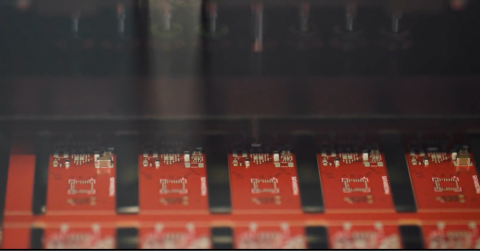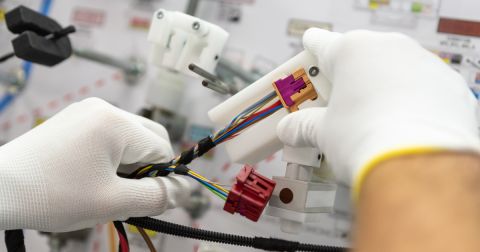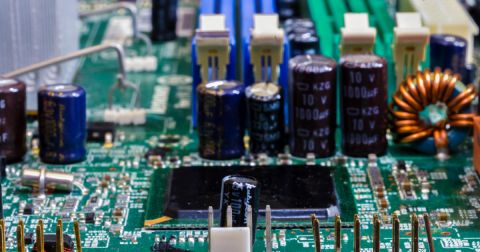How Integrated Tools Ease Multi-Board PCB Systems Design

If you've ever taken apart a computer, you know that the entire system can't fit on a single PCB. Multi-board PCB design systems are the most complicated devices used in a variety of applications, and designing them takes imagination, planning, and the right design software.
Multi-board systems often require different modules to perform specialized functions, with connections established through various interconnect solutions, including standard connectors, flex ribbons, and custom cable harnesses. Rigid-flex PCBs are one multi-board system type that incorporates rigid and flexible sections, but not all multi-board designs require a rigid-flex approach. Regardless of the type, designing multi-board systems effectively requires the best design tools in a unified environment.
Structuring Your Multi-Board Design
When creating a multi-board PCB design, it's best to start with a high-level system view before diving into schematics. Multi-board systems integrate a variety of modules, each serving a distinct function. If you create a system diagram, you can easily determine how different modules should be connected across separate PCBs or integrated as COTS (commercial off-the-shelf) components.
For instance, a computer's functions are separated into distinct modules—display, memory, and networking. Following this approach in your multi-board PCB design makes it easier to optimize PCB stack-ups. Instead of using the maximum layer count throughout a single board, separating modules onto different PCBs allows you to tailor the layer count based on specific needs. Some modules might require a complex HDI multilayer board, while others can function with a simple 4-layer PCB, reducing fabrication costs.
Your packaging specifications will define the size and shape of each module's PCB, considering factors such as enclosure constraints, thermal management, and mechanical integration. If your multi-board system requires flexibility, a flex ribbon may be necessary to connect multiple boards, allowing for movement and compact stacking while maintaining reliable signal and power transmission. In cases where flexibility is not required, standard connectors and custom cable harnesses can be robust interconnects between boards, ensuring efficient electrical performance and mechanical stability. The choice of interconnection method depends on factors such as signal integrity, impedance matching, EMI control, and ease of manufacturing, all of which must be carefully evaluated during the multi-board PCB design process.

Challenges in Multi-Board PCB Design
Designing a multi-board PCB system introduces unique challenges that single-board designs do not face. One of the biggest difficulties is managing interconnections between multiple PCBs and COTS components while ensuring reliable power and signal transmission. Poorly designed interconnects can lead to EMI issues, signal degradation, power losses, and mechanical failures. Engineers must carefully select connection methods, such as flex cables, rigid connectors, or custom cable harnesses, each requiring specific design considerations like impedance matching, crosstalk mitigation, shielding, and mechanical durability. Properly designed cable harnesses help organize multiple signal and power connections, reduce assembly complexity, and improve system reliability.
Mechanical constraints add another layer of complexity, as multiple boards must fit within the final enclosure while maintaining proper spacing, thermal dissipation, and manufacturability.
A well-structured design environment should include a layer stack-up manager that allows customization of each PCB's structure within a single project, making it easier to define board-to-board connections and flex regions when designing multi-board systems. Many design tools force engineers to work with separate projects for different boards, making simulation, analysis, and verification inefficient. Ideally, all design features should be managed within a single software environment that integrates 3D visualization, simulation, and rule-checking tools to prevent mechanical misalignment, signal integrity issues, and electrical failures before production.
Validating a multi-board system is not just about verifying schematic connections—it requires integrated simulation to diagnose potential power and signal problems across multiple PCBs and cable harnesses. If the design software does not provide a unified system, engineers are often forced to switch between different tools, increasing the risk of data inconsistencies and reducing efficiency. Many PCB platforms only offer essential simulation, verification, and visualization features as separate add-ons, making the design process more fragmented. A truly unified PCB design solution simplifies multi-board system development, allowing engineers to streamline design processes, improve connectivity, and ensure seamless integration across the entire system while optimizing interconnections and cable harness designs for reliable performance.
The Best Multi-Board Design Tools
Working with multi-board and rigid-flex systems requires 3D design and visualization tools that allow engineers to see how PCBs interact as a single system. Historically, mechanical and electrical design teams have been siloed because design software in each area was never fully integrated. However, when your software combines MCAD and ECAD capabilities in a single program, teams can collaborate efficiently on board size, arrangement, and functionality, streamlining the overall design process.
True MCAD/ECAD collaboration allows PCB designers to work with mechanical engineers and DFM specialists to analyze board placement within a 3D model, preventing mechanical conflicts before fabrication. Instead of relying on an iterative file exchange process, where designs must be passed back and forth between teams, modern 3D modeling tools allow organizations to share .STEP files, ensuring that all stakeholders work in a single design environment.
Multi-board design becomes significantly easier when your PCB design software supports hierarchical schematics. When dividing your system into different modules, each module can be assigned its own schematic, which can be linked just as in a system block diagram. This modular approach simplifies multi-board design, capturing each design portion on different PCBs while maintaining logical connectivity.
For board-to-board connections, whether using standard connectors, cable harnesses, or flex ribbons, your design software should include a layer stack-up manager that defines how interconnects interact with internal PCB layers. Your CAD tools should make it easy to visualize board arrangements in 2D and 3D, while your routing tools should simplify the interconnecting routing across different boards.

Multi-PCB Design in Altium's Unified Design Environment
Altium provides a unified environment that integrates powerful CAD tools, layer stack-up management, multi-board connectivity, and design rule checking in a single intuitive interface. Its hierarchical design features are essential for multi-board PCB system development, as they allow for easy linking of components across different modules while ensuring proper electrical and mechanical integration.
Working within Altium's integrated ECAD/MCAD design tools enables real-time collaboration between development teams. Unlike other PCB design platforms, which require switching between separate design tools, Altium allows teams to work together seamlessly, leading to more accurate models, fewer production errors, and reduced time to market.
Altium offers greater flexibility than PCB design software, with seamless import/export capabilities between 3D design tools like SolidWorks. If you're switching from another PCB design tool, migrating existing designs to Altium's format is straightforward, ensuring a smooth transition without losing design data.
Altium provides integrated solutions for multi-layer, multi-PCB, and modular system designs for those looking for the best multi-board design software. Its intuitive interface, powerful 3D viewer, and advanced hierarchical features make it easy to manage layer stack-up configurations, board arrangement, and interconnects—all in one place.
Get Started with Altium Today
Altium provides many resources, including design examples, an active user forum, video tutorials, and expert-led webinars to help designers master advanced PCB tools. Whether you’re an experienced engineer or new to multi-board PCB design, Altium gives you the tools and support you need to succeed.
Interested in exploring multi-board PCB design? Discover how Altium Develop makes it easy to create complex designs and error-free system interconnections.












 Back
Back